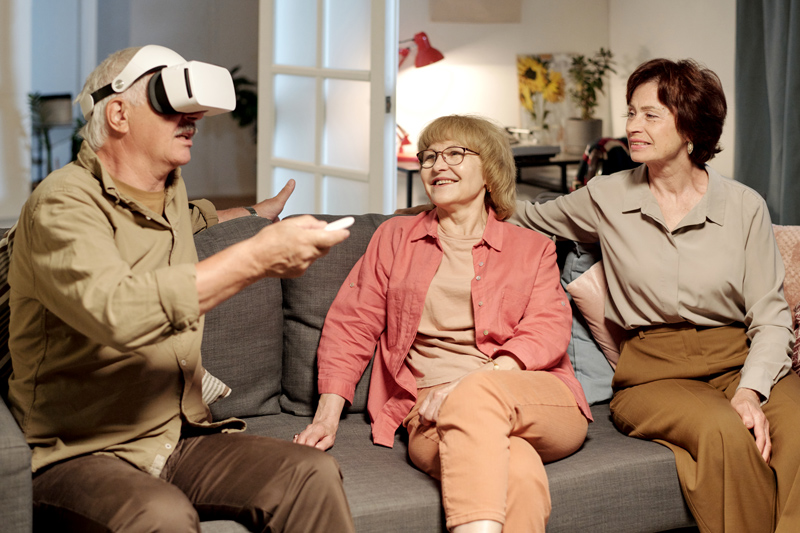Social isolation refers to the lack of meaningful friendships, connections, and relationships in one’s life, whereas loneliness is the perception of the feelings associated with isolation (Wu, 2020). Wu (2020) reported that one-quarter of older people living in-community report feelings of loneliness and lack of social connections. Key consequences of social isolation and loneliness may include a decline in both mental and physical health, an increase in substance use and self-medication, and a rise in destructive behaviors together with a decrease in healthy behaviors. Social isolation limits physical activity, which can worsen chronic illness, heart disease, obesity, and other conditions that require activity to maintain health and prevent decline (Lee & Coughlin, 2014).

A virtual reality (VR) program was developed to explore the use of VR with older participants enrolled in a Personalized Recovery-Oriented Services (PROS) program at a behavioral health agency. PROS supports individuals in setting personal goals, developing life skills, and maintaining community connections through an integrated approach that combines treatment, support, and skill-building in a person-centered environment. This study explored whether use of VR affected feelings of loneliness and social connectedness. Implementation science principles guided the integration of the evidence-based VR program by identifying barriers and facilitators to implementation and by employing strategies to address these challenges (Wensing et al., 2022).
Social isolation and loneliness, often linked to a lack of social connections, pose an ongoing threat to physical and mental health across all age groups. Among older adults, the issue remains prevalent and according to the University of Michigan National Poll on Healthy Aging (Malani et al., 2023), 56% of respondents aged 50–80 reported feeling socially isolated during the COVID-19 pandemic. While this rate has since declined, one in three older adults (34%) continue to experience social isolation and resulting loneliness.
Fakoya and colleagues (2020) identified risk factors contributing to loneliness in older adults, many tied directly to lack of social connectedness and include poor health, cognitive impairment, lower socioeconomic status and neighborhood deprivation. According to Ang (2022), social connectedness refers to having meaningful relationships, engaging socially, and taking part in community life. It serves as a protective factor that can reduce loneliness and strengthen one’s sense of belonging. Hughes et al. (2017) researched social isolation and loneliness among older adults, identifying it as a global health issue and a significant risk to overall well-being. The authors proposed that technology could help overcome barriers to socialization, such as physical distance, mobility challenges, and individual crises. Additionally, their research found that older adults generally hold positive attitudes toward virtual reality (VR), suggesting that further exploration of its use is warranted. Virtual reality (VR) has emerged as an innovative and engaging intervention in addressing loneliness and increasing feelings of connectedness among older adults (Lin et al., 2018). While promising, the research base examining VR specifically with and for older populations remains limited. Hughes and colleagues (2017) called for additional studies to better understand how older adults engage with VR and to determine best practices for use.
Older adults are often perceived as non-users of technology, which may create barriers to program adoption. However, as VR becomes more accessible and older individuals gain experience and confidence, stigma (both internalized and external) will likely diminish (Hughes et al., 2017). Novelty, adaptability, portability, and customization potential of VR make it a suitable tool for addressing diverse needs, including cultural considerations, trauma histories, and individual preferences. While self-stigmatizing barriers were expected, participants did not indicate that these barriers affected their engagement with the intervention.
Methods
Virtual reality (VR) enables users to engage in fully immersive, digitally created environments through specialized headsets. In this study, PROS participants collectively explored a range of experiences, including virtual travel abroad, piloting an F-16 fighter jet, and climbing Nepal’s highest peaks. Lightweight, user-friendly devices were provided by Viva Vita VR for the purpose of this study. Several participants reported mild dizziness during a downhill skiing simulation; however, participants noted that symptoms subsided with time and did not interfere with participation. For safety, all participants remained seated throughout the intervention.
Twelve PROS participants, all aged 60 or older, volunteered to take part in a four-week VR program. Sessions were held twice weekly, each lasting 45 minutes, in small groups to allow for individualized guidance. Groups were facilitated by the Primary Investigator (PI) and staff. Each session followed a consistent structure, beginning with 5–10 minutes of group discussion to collaboratively select the VR content. This was followed by 10–20 minutes of guided immersive experience using the VR headsets. Sessions concluded with approximately 10 minutes of debriefing, during which participants reflected on their experiences and provided feedback. A trauma-informed (TI) framework (Bargeman et al., 2021) guided all phases of implementation, from recruitment through post-intervention focus groups. Applying TI principles promoted safety, trust, and empowerment, providing reassurance for participants with potential trauma histories.
Data Collection
Twelve participants completed anonymous baseline and post-intervention surveys including the De Jong Gierveld Loneliness Scale (De Jong Gierveld et al., 2006) and the Social Connectedness Scale (Lee et al., 1995). Both instruments employed Likert-type response formats. Surveys were administered to participants at baseline and immediately following the final VR session. Data were analyzed using descriptive statistics to summarize central tendency (mean and standard deviation). Paired sample t-tests were subsequently conducted to evaluate whether observed changes in mean scores between baseline and post-intervention assessments reached statistical significance.
Results
Participant responses showed measurable improvements from baseline to post-testing, with loneliness scores decreasing, and social connectedness scores increasing. Post-intervention focus groups provided qualitative feedback directly from participants. Responses to eight open-ended questions were coded and analyzed using Thematic Analysis (Nowell et al., 2017), identifying key patterns and gaining insight into participant experiences. Participants noted improvements in mood, sharing reactions such as “mood was better,” “felt happier,” “I felt lighter,” and “(VR) took away stress.” Other comments included “wonderful feeling,” “feel good, calmer,” and one participant said, on several occasions, that the VR experience “takes mental illness away.”
Conclusion
Both qualitative and quantitative data demonstrated that VR increased participants’ feelings of connectedness and lessened their feelings of loneliness. Post-intervention focus groups indicated that participants looked forward to their VR experiences and expressed a desire to continue using VR both in the PROS program and at home if possible. As a result, VR programming has been integrated into the Envision Wellness PROS program. According to a PROS counselor, participants recently enjoyed virtual art gallery tours; although some participants reported initial hesitation, once engaged with the headsets they demonstrated enthusiasm and noted that the experience was more manageable than anticipated.
In summary, although quantitative data did not demonstrate statistically significant changes, the qualitative data indicated otherwise and suggested that the use of VR did in fact promote change with older adults in a PROS program related to feelings of loneliness and social connectedness. The primary limitation of this study was the small sample size (n = 12) and the short duration of the intervention. Nevertheless, all participants who enrolled completed the program and actively engaged in the data collection process.
It is important to note that without a strong implementation science framework, evidence-based programs risk limited viability, potentially leading not only to wasted resources but also to compromised trust among participants who might have otherwise benefited from a more sustainable, long-lasting intervention (Cabassa, 2016). The consistently positive experiences reported by participants in this project demonstrate the promise of virtual reality as a tool for enhancing well-being and social connectedness. These findings highlight the potential value of integrating VR into myriad public health programs, offering meaningful benefits for individuals across the lifespan.
“The critical thing to understand is that building for a historically marginalized group results in better outcomes for everyone.” (Annie Jean-Baptiste retrieved from www.mckinsey.com)
Heidi Billittier, DSW, LMSW, is Chief Operating Officer at Envision Wellness WNY. Heidi is committed to using innovative strategies, including technology, to dismantle aging stereotypes and promote the health and well-being of older adults. Correspondence and requests for data from the VR program should be addressed to Heidi Billittier, at hbillittier@envisionwellnesswny.com.
References
Bargeman, M., Smith, S., & Wekerle, C. (2021). Trauma-informed care as a rights-based “standard of care”: A critical review. Child Abuse & Neglect, 119(Pt 1), 104762–104762. https://doi.org/10.1016/j.chiabu.2020.104762
Cabassa, L. J. (2016). Implementation Science: Why It Matters for the Future of Social Work. Journal of Social Work Education, 52(Suppl 1), S38–S50. https://doi.org/10.1080/10437797.2016.1174648
De Jong Gierveld, J., & Van Tilburg, T. (2006). A 6-Item Scale for Overall, Emotional, and Social Loneliness: Confirmatory Tests on Survey Data. Research on Aging, 28(5), 582–598. https://doi.org/10.1177/0164027506289723
Fakoya, O. A., McCorry, N. K., & Donnelly, M. (2020). Loneliness and social isolation interventions for older adults: a scoping review of reviews. BMC Public Health, 20(1), 129–129. https://doi.org/10.1186/s12889-020-8251-6
Hughes, S., Warren-Norton, K., Spadafora, P., & Tsotsos, L. (2017). Supporting Optimal Aging through the Innovative Use of Virtual Reality Technology. Multimodal Technologies and Interaction, 1(4), 23-. https://doi.org/10.3390/mti1040023
Lee, R. M., Robbins, S. B., & Hill, C. E. (1995). Measuring Belongingness: The Social Connectedness and the Social Assurance Scales. Journal of Counseling Psychology, 42(2), 232–241. https://doi.org/10.1037/0022-0167.42.2.232
Lin, C.X., Lee, C., Lally, D., & Coughlin, J.F. (2018). Impact of Virtual Reality (VR) Experience on Older Adults’ Well-Being. In: Zhou, J., Salvendy, G. (eds) Human Aspects of IT for the Aged Population. Applications in Health, Assistance, and Entertainment. https://doi.org/10.1007/978-3-319-92037-5_
Malani, P., Singer, D., Kirch, M., Solway, E., Roberts, S., Smith, E., Hutchens, L., & Kullgren, J. (2023). Trends in loneliness among older adults from 2018-2023. University of Michigan National Poll on Healthy Aging. https://dx.doi.org/10.7302/7011
Nowell, L. S., Norris, J. M., White, D. E., & Moules, N. J. (2017). Thematic Analysis: Striving to Meet the Trustworthiness Criteria. International Journal of Qualitative Methods, 16(1), 1–13. https://doi.org/10.1177/1609406917733847
Wensing, M., Sales, A., Aarons, G. A., et al. (2022). Evidence for objects of implementation in healthcare: Considerations for Implementation Science and Implementation Science Communications. Implementation Science, 17(83). https://doi.org/10.1186/s13012-022-01249-w




